With the rapid growth of nanotechnology, nanomaterials are widely used in many fields and have an important effect on the global economy[1]. Due to its excellent bactericidal properties, silver nanoparticles (AgNPs) have become one of the most widely used applications and production of many consumer products[2]. However, with the increasing use of consumer products containing AgNPs, AgNPs can inevitably be released into aquatic ecosystems, which have negative effects on organisms[3-4]. Most unfortunately, the bioconcentration of AgNPs through the food chain of aquatic ecosystems threatens human health[5]. Maurer-Jones et al.[6] reported that AgNPs concentrations in natural water, in the effluent of wastewater treatment plants (WWTPs), and in sewage sludge were 0.088 to 1×104 ng/L, 0.016 4 to 17 μg/L, and 1.29 to 39 mg/kg, respectively, by the risk assessment model. Thus, understanding the fate and behavior of AgNPs in different environmental and biological systems can help improve the risk assessment.
Currently, most of the studies about AgNPs toxicity focus on the animal systems[7]. However, the fate of AgNPs and plant adsorption of AgNPs in a plant system have not been completely studied. Lin and Xing[8] reported that nanoparticles can be absorbed by plant roots. In the quarter-strength hoagland solution, Lee et al.[9] found that the silver concentration of Arabidopsis thaliana in the AgNPs’ systems was higher than that in the AgNO3 systems. Further exploration of the detailed processes of AgNPs accumulated in different tissues of Arabidopsis thaliana were conducted. During the growth of plants, AgNPs first attached to the surface of primary roots and then entered the root tips, and finally AgNPs reached the vascular tissue throughout the whole plant from root to shoot[10]. In an aquatic system, Harris and Bali[11] found that the species of plants, the initial AgNPs concentration, and exposure time were the primary factors affecting the uptake of plants to silver. Marciano et al.[12] explored the further understandings of the adsorption of plant to AgNPs, showing that the silver nanoparticles can attach onto the outside of the cuticle. Quah et al.[13] found that the Ag type (e.g., ionic, nanoparticles, and bulk) and plant species significantly affected the transport efficiency of AgNPs from roots to shoots, and the upward transportation of AgNPs (20 to 50 nm) was considerably more substantial than that of bulk Ag (1 to 3 μm). These results indicate that there is the possibility of AgNPs removal through the functions of plants’ uptake in an aquatic system.
Constructed wetlands (CWs) are recognized as efficient wastewater treatment systems. Moreover, plants are the main parts and have many important functions in CWs[14]. Hence, the behavior study of AgNPs in a simple hydroponic system could lay the foundation to well understanding the migration of silver nanoparticles in CWs. Elemental silver (0 oxidation state Ag0) and the monovalent silver ion (Ag+) are the two most commonly encountered silver forms, and are thus used in most of environmental studies[15].
After entering aquatic ecosystems, some AgNPs are directly absorbed by micro-organisms and plants, some are oxidized and release Ag+[16], which is then absorbed by micro-organisms and plants or aggregated, and some are vulcanized, chlorinated or recombined to settle directly into sediments[17]. Based on these pathways of migration for AgNPs in an aquatic ecosystem, a conceptual model of AgNP migration was developed. In this study, a migration model of AgNPs was constructed. A hydroponic system with Eichhornia crassipes was used for the research and the silver concentrations in water and different plant tissues were examined to determine the absorption and translocation processes of AgNPs in an aquatic ecosystem. To further explore the absorption and transportation mechanisms of AgNPs, a comparative study of AgNPs and AgNO3 on the variation in silver concentrations in water and plant tissues was also conducted.
1 Materials and Methods
1.1 Test plant
The test plants (Eichhornia crassipes) were brought from a wetland at Shuyang, Jiangsu Province. All plants were cultivated in an identical environment with the identical concentration of nutrient solution, which was diluted from Hoagland medium (calcium nitrate 945 mg/L, potassium nitrate 607 mg/L, ammonium phosphate 115 mg/L, magnesium sulfate 493 mg/L, iron salt solution 2.5 mL and trace elements solution 5 mL). The iron salt solution was formulated by dispersing ferrous sulfate heptahydrate 2.78 g and EDTA disodium 3.73 g in 500 mL DI water. The composition of trace elements solution was boronic acid 6.2 mg/L, manganese sulfate 22.3 mg/L, zinc sulfate 8.6 mg/L, sodium molybdate 0.25 mg/L, copper sulfate 0.025 mg/L, and cobalt oxide 0.025 mg/L. Healthy and uniform plants were selected for the tests.
1.2 Nanomaterial
The silver nanoparticles suspension (purchased from Shanghai Huzheng Nano Technology Co., Ltd., Shanghai, China) used in this study have the following characteristics: The Ag content of AgNPs suspensions is greater than 99.99% with the average particle diameter of AgNPs of 15 nm and the solids content (Ag) of 2 000 mg/L. The AgNPs suspensions are obtained by coating Ag particles with polyvinyl pyrrolidone (PVP). The monomer suspension of silver nanoparticles is observed by a transmission electron microscope (TEM), as shown in Fig.1, and the particles are finely dispersed and are uniform with diameters from 10 to 40 nm.
1.3 Migration model

Fig.1 TEM photograph of AgNPs suspension
Due to the complexity of aquatic ecosystems and the diversity of factors influencing the migration of AgNPs, the aquatic ecosystem conceptual model was simplified into a hydroponic system (see Fig.2). To study the migration, absorption and transportation of AgNPs in this aquatic ecosystem, the changes in concentrations of the AgNPs in the water and the absorption by plants were monitored. The Eichhornia crassipes hydroponic system was constructed based on the simplified model. Uniformly, growing plants were selected, roots and leaves were washed with pure water, and plants were placed separately in 1 L beakers. Diluting 2 000 mg/L stock suspension of AgNPs by using DI water, different AgNP suspensions of initial concentrations at 1×101, 1×102, 1×103, 2×104 μg/L are obtained to evaluate the transport of different magnitude concentrations of AgNPs in the hydroponic systems. Due to the fact that the form of AgNPs in suspensions is particles, leading to the nonuniform of the AgNPs suspensions when diluting the AgNP stocks, thus causing concentration error. Before the test plants (Eichhornia crassipes) were grown into the beakers, the actual Ag concentration of the AgNP suspensions at 1×101, 1×102, 1×103, 2×104 μg/L was detected by inductively coupled plasma-mass spectrometry (ICP-MS). The results about the actual Ag concentrations were 15.93, 93.30, 1 224.00, and 25 950.00 μg/L, respectively. Each beaker was added to by 1 000 mL AgNP suspensions. After the AgNP suspensions were added to the bea-kers, the breathable membranes (PM 996, Parafilm M®, US) were used to cover the beakers in order to minimize water evaporation from them. When the plants were cultivated in the beakers, a hole was made in the middle of the membranes. The beakers were placed in a constant-temperature incubator and were maintained at 25 to 30 ℃ for 16 h during day and at 15 to 20 ℃ for 8 h during the night.
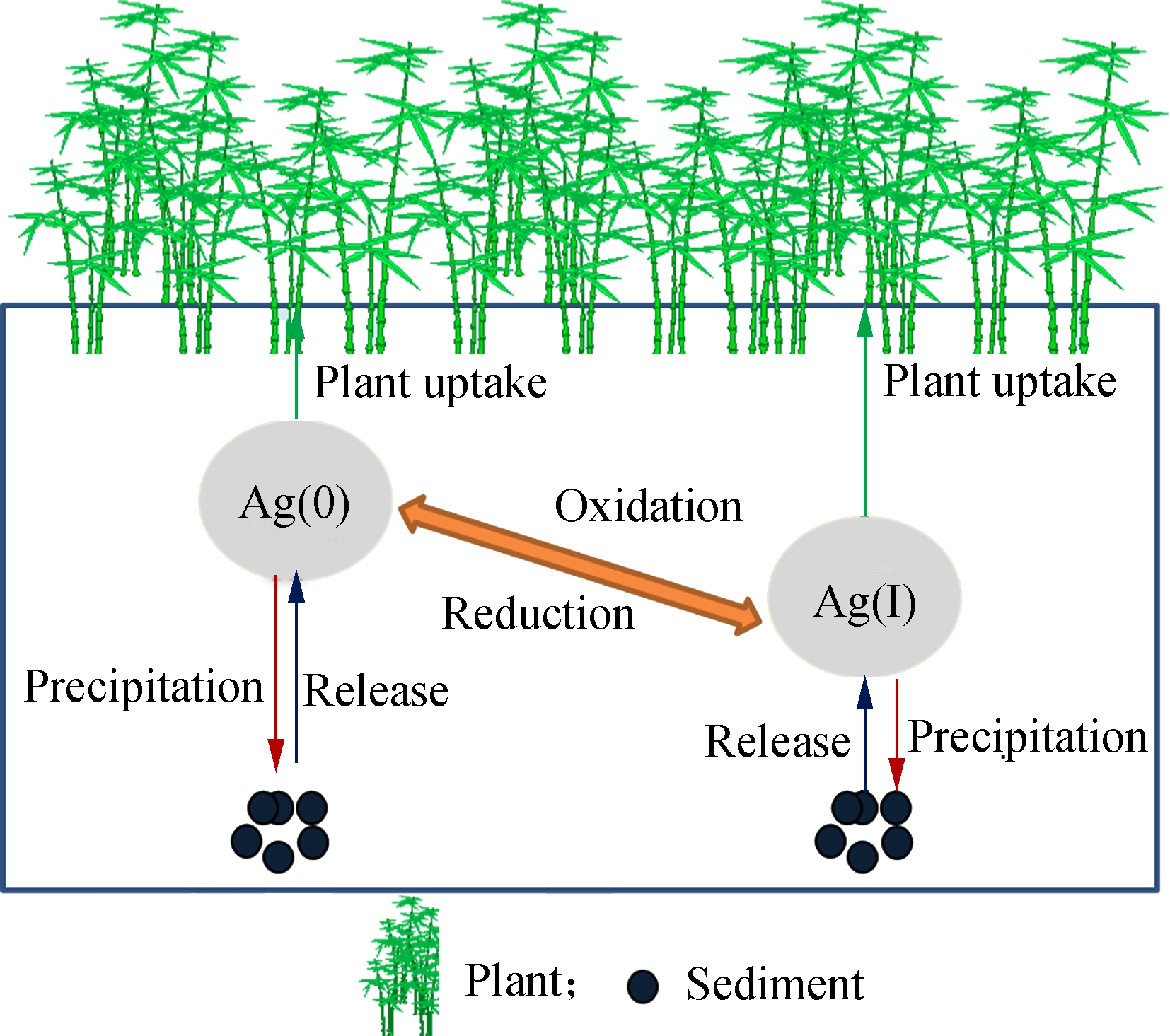
Fig.2 Simplified model of migration of AgNPs in an aquatic ecosystem
1.4 Determination of Ag concentration
The water samples were collected from the middle layer of the beakers on 1, 3, 5, 10, 15 d post exposure. Following the US environmental protection agency (EPA) method 200.8, inductively coupled plasma mass spectrometry (ICP-MS) was used to measure the silver concentrations in water before treatment. After 15 d, the roots and stems of plants were digested and treated before measurements, and ICP-MS was used to determine the silver concentrations in plant tissues.
1.5 Data analyses
Original software was applied to chart the experimental data. SPSS 19.0 software was used for statistical analyses. An analysis of variance (ANOVA) was used to test the significance of results, and p<0.05 was considered to be statistically significant.
2 Results and Discussion
2.1 Migration fate of AgNPs at different concentr-ations
To explore the migration pathways of AgNPs in these aquatic ecosystems, the change in concentration of the silver in the water was monitored for different initial concentrations of AgNP stress (see Fig.3).
As shown in Fig.3, the concentrations of the silver in the water declined to different degrees at different initial concentrations of AgNPs. Under the high initial AgNPs concentrations (1×103 and 2×104 μg/L), silver concentrations in the water declined sharply after 1 d, and then the declining trend slowed and was followed by an increasing trend with the increase in AgNPs concentration later. Under low initial concentrations of AgNPs (1×101 and 1×102 μg/L), silver concentrations initially showed a sharp decrease and were followed by gradual decline. Therefore, the silver concentration in water declined at different initial concentrations, which may be explained by the settlement of AgNP aggregates formed by inter-particle bonding in the water[18] or by the absorption of plant roots to Ag+ and some proportion of the AgNPs[19]. The increase of silver concentration in the water observed later in the study at high concentrations (1×103 and 2×104 μg/L) might be the reason for the release of Ag+ or AgNPs from the sediment. Additionally, due to high AgNPs concentrations over a longer period, plant roots might be stimulated to produce dissolved organic matter (DOM), humic acids and other substances. The PVP-coated AgNPs were adsorbed onto the surface of the DOM, which can reduce the settlement of AgNPs[20] and keep AgNPs steadily dispersing in the water phase.
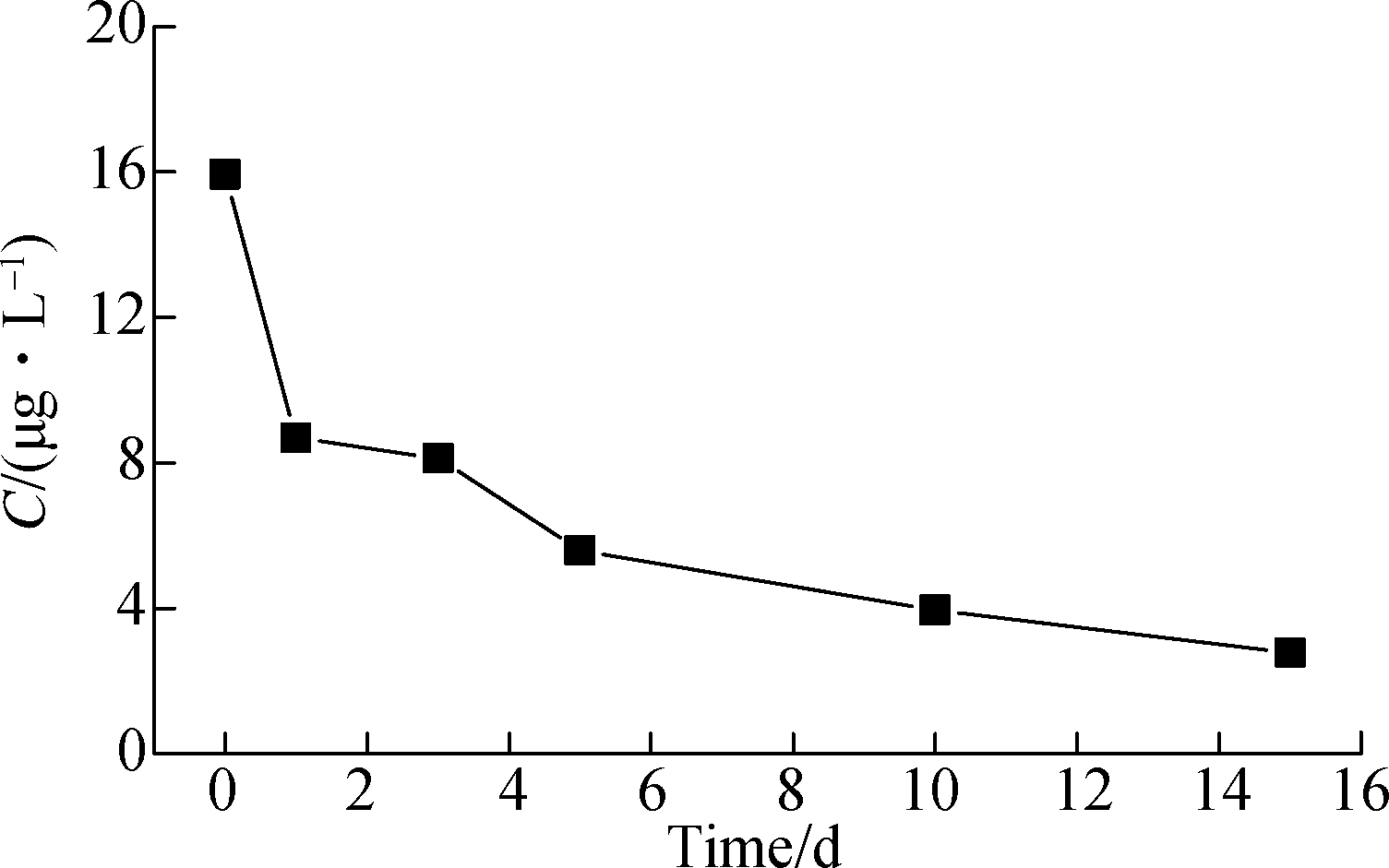
(a)

(b)

(c)
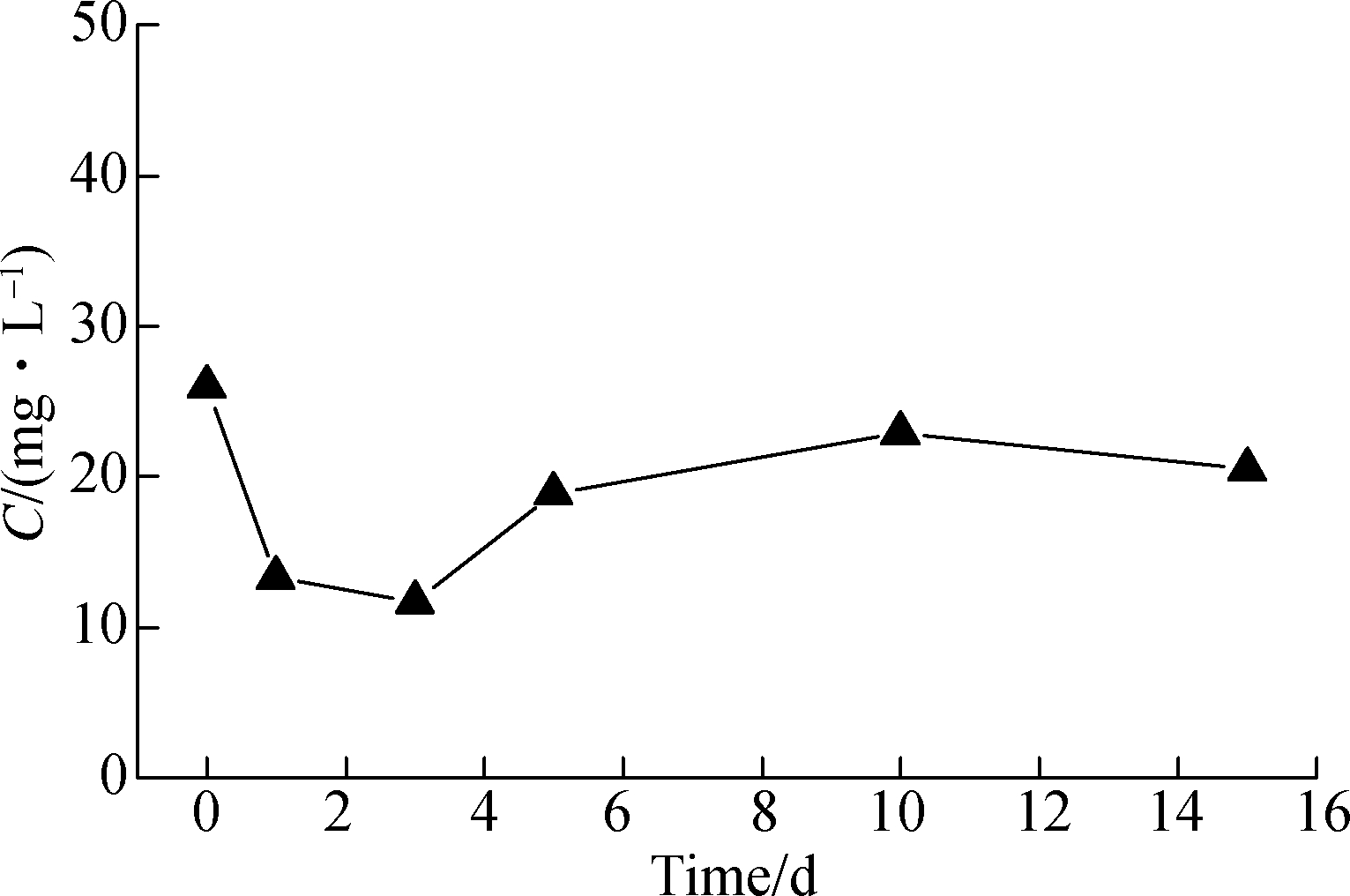
(d)
Fig.3 Changes in the silver concentrations during the water phase at different AgNPs concentrations in hydroponic systems. (a) 1×101 μg/L;(b) 1×102 μg/L; (c) 1×103 μg/L ; (d) 2×104 μg/L
2.2 Comparison of the migration fates of AgNPs and Ag+
To further explore the transport and absorption mechanisms of AgNPs, the changes in silver concentration were compared to a hydroponic system with Eichhornia crassipes at different concentrations of AgNPs or AgNO3 (see Fig.4).
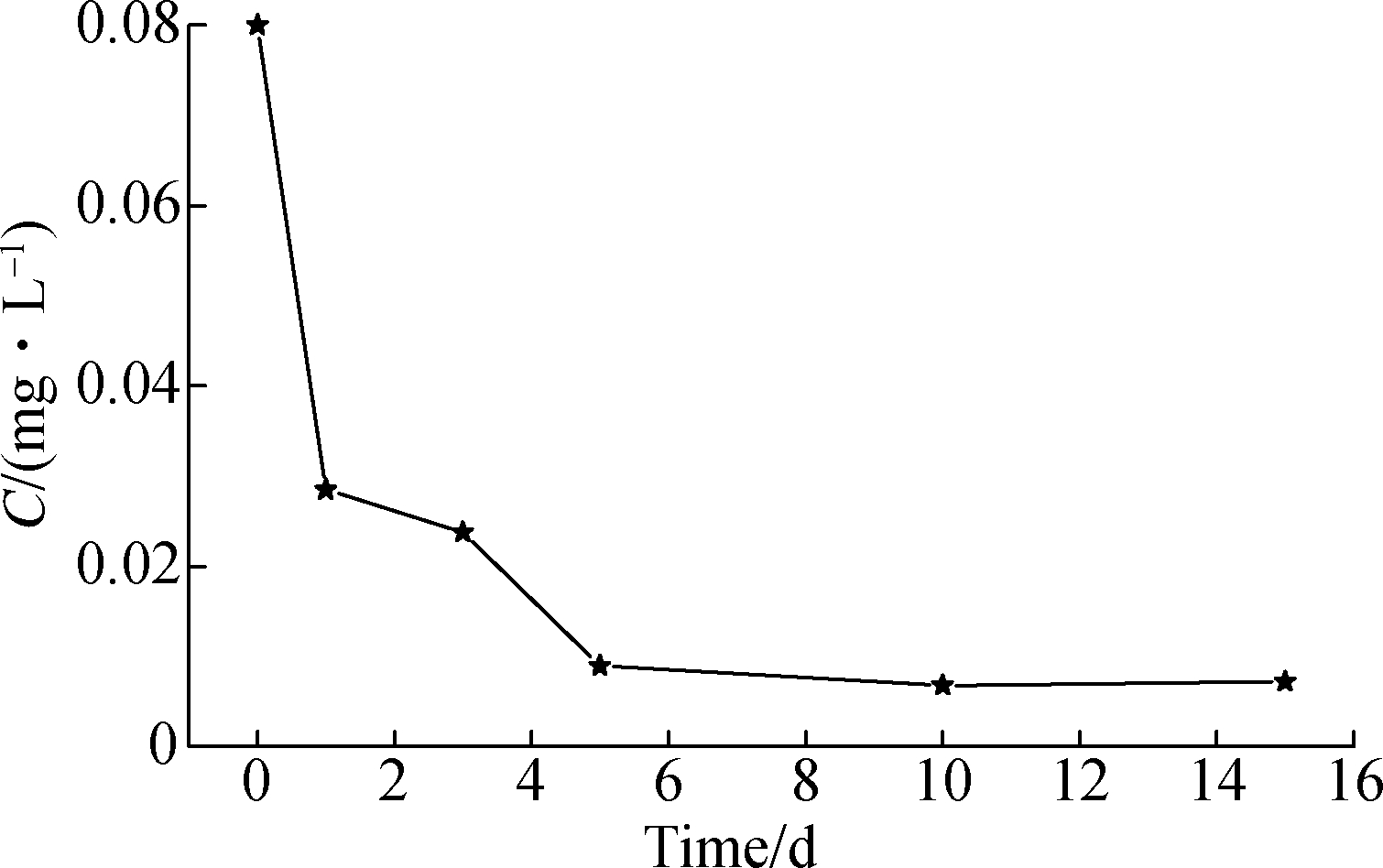
(a)

(b)
Fig.4 Changes in the silver concentrations at different AgNO3 concentrations in the hydroponic systems. (a) 1×102 μg/L AgNO3;(b) 1×103 μg/L AgNO3
As shown in Fig.4, the continuous decline of silver concentration was found in the systems with an initial concentration of 1×103 μg/L AgNO3, which was different from that of the AgNP system (1×103 μg/L AgNPs). The AgNPs in hydroponic systems are affected by many factors and, therefore, they remain in an unstable state and may be released into the water after settling following reunion[21]. The removal rates of silver were 35.87%, 91.00%, 71.56%, and 96.01% under initial concentrations of 1×103 μg/L AgNPs, 1×103 μg/L AgNO3, 1×102 μg/L AgNPs, and 1×102 μg/L AgNO3, respectively. On the one hand, compared with the size range of 10 to 40 nm for AgNPs, Ag+ more easily entered plant cell walls and membranes, increasing the AgNPs removal by plant adsorption. On the other hand, the DOM released from plant roots affected the aggregation and precipitation of AgNPs, which led to the stable status of AgNPs in the system[20]. For AgNO3, the removal efficiencies of silver were similar at both concentrations; whereas the removal efficiencies were largely different at different AgNP concentrations. Thus, under high concentrations, the silver removal in the AgNPs system was quite different from that in the AgNO3 system.
2.3 Plant uptake and transportation of AgNPs at different concentrations
Plants are an important component in aquatic ecosystems that must be considered in the analyses of the transformation processes of AgNPs. However, little research has been conducted on the effect of plants on the uptake, transport and accumulation of AgNPs. In this research, the silver concentrations of roots and leaves of Eichhornia crassipes were measured at different concentrations to quantify the accumulation of silver in plant tissues and to further explicate the adsorption and migration processes of AgNPs in plant bodies. After 15 d, with different AgNPs concentrations in the hyacinth hydroponic systems, the silver concentrations in plant tissues were measured after digestion. Silver concentrations in plant roots and stems are shown in Fig.5.
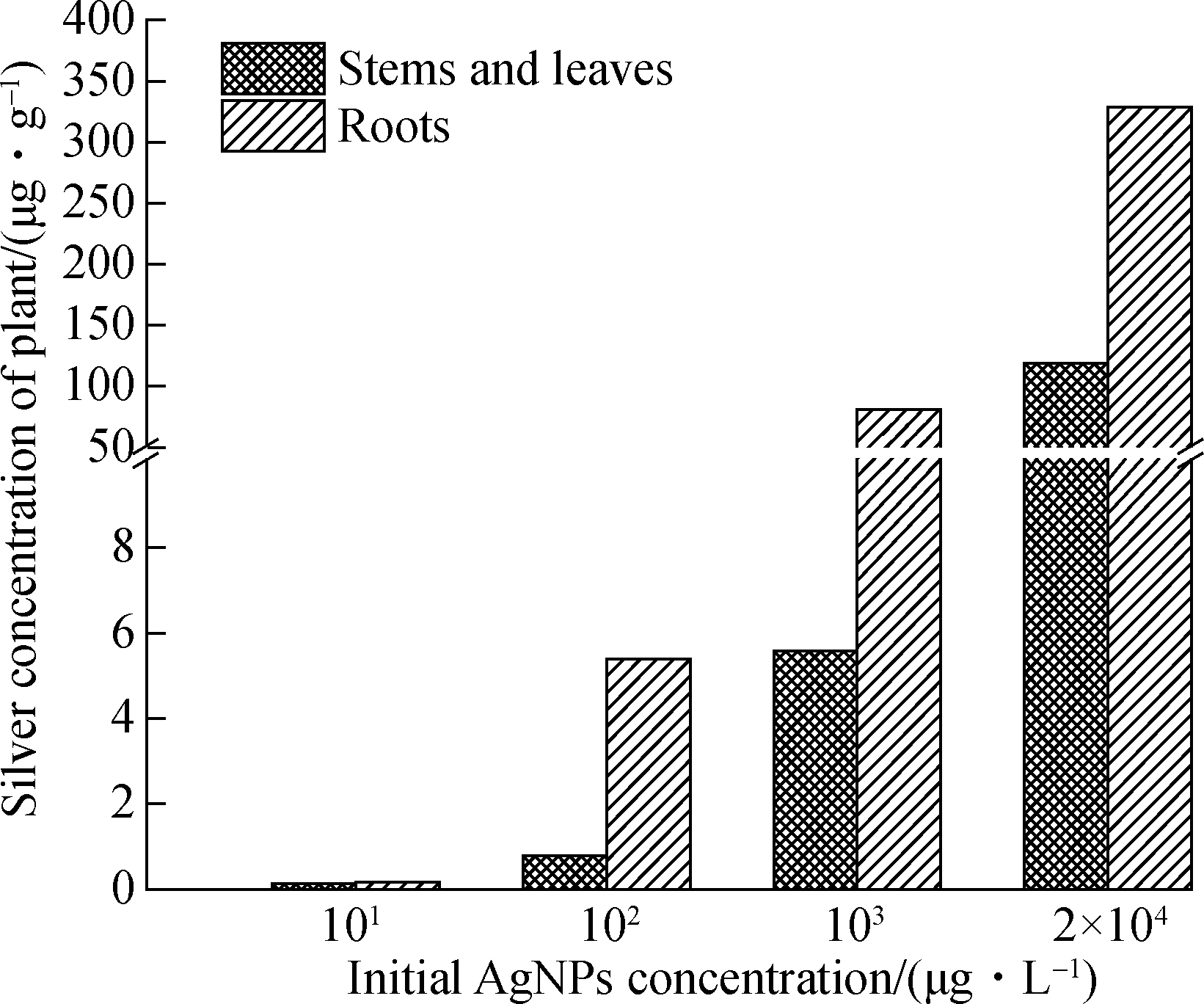
Fig.5 Silver concentrations in the tissues of Eichhornia crassipes after 15 d culture in hydroponic systems with different initial concentrations of AgNPs
As shown in Fig.5, a close relationship was observed between the initial AgNPs concentration and the silver concentration in plant tissues. Under different concentrations of AgNPs (1×101, 1×102, 1×103, and 2×104 μg/L), the silver concentrations accumulated in roots (dry weight) were 0.17, 5.40, 80.96, and 328.80 μg/g, respectively. A significant correlation was detected between the initial concentration and the concentration of silver accumulated in roots (r=0.98, p<0.05). The concentrations of silver that accumulated in leaves (dry weight) were 0.13, 0.78, 5.58, and 118.80 μg/g, respectively, and the correlation was also significant (r=1, p<0.001) between the initial concentrations and the silver concentrations in leaves. Thus, within the tested range of AgNPs concentrations in this study, the silver concentrations were higher in the roots than that in the leaves. These results were consistent with Ref.[22].
At the identical concentration of AgNPs, the silver concentration in plant stems and leaves was lower than that in plant roots, which accounted for 77.0%, 14.6%, 6.89%, and 36.1% in the leaves of silver concentrations in the roots at different initial concentrations of AgNPs (1×101, 1×102, 1×103, and 2×104 μg/L, respectively). Therefore, most of the silver accumulated in plant roots, with only a portion transferred to the stems and leaves, which indicated the larger capability of roots for enrichment of silver. In contrast to these results, some scholars hypothesize that nanoparticles cannot enter plant cells because the apertures of the plant cell wall are generally 3 to 20 nm[22]. Moreover, macromolecules and nutrients can enter cells via osmotic and water potential, whereas larger particles cannot penetrate the cell wall[23]. However, due to the diameters of AgNPs between 10 to 40 nm in this experiment, the particles might directly enter through the holes in the root epidermis cell wall. After entering the apoplast xylem, the AgNPs can transfer through the plant with the moisture transpiration and nutrient flows[24].
2.4 Comparison of plant uptake and transport of AgNPs and Ag+
To compare the plant uptake and transport process of AgNPs and Ag+, Eichhornia crassipes was cultured in the hydroponic systems with different initial concentrations of AgNPs or AgNO3 for 15 d. The silver concentrations in plant tissues were determined following digestion (see Fig.6).
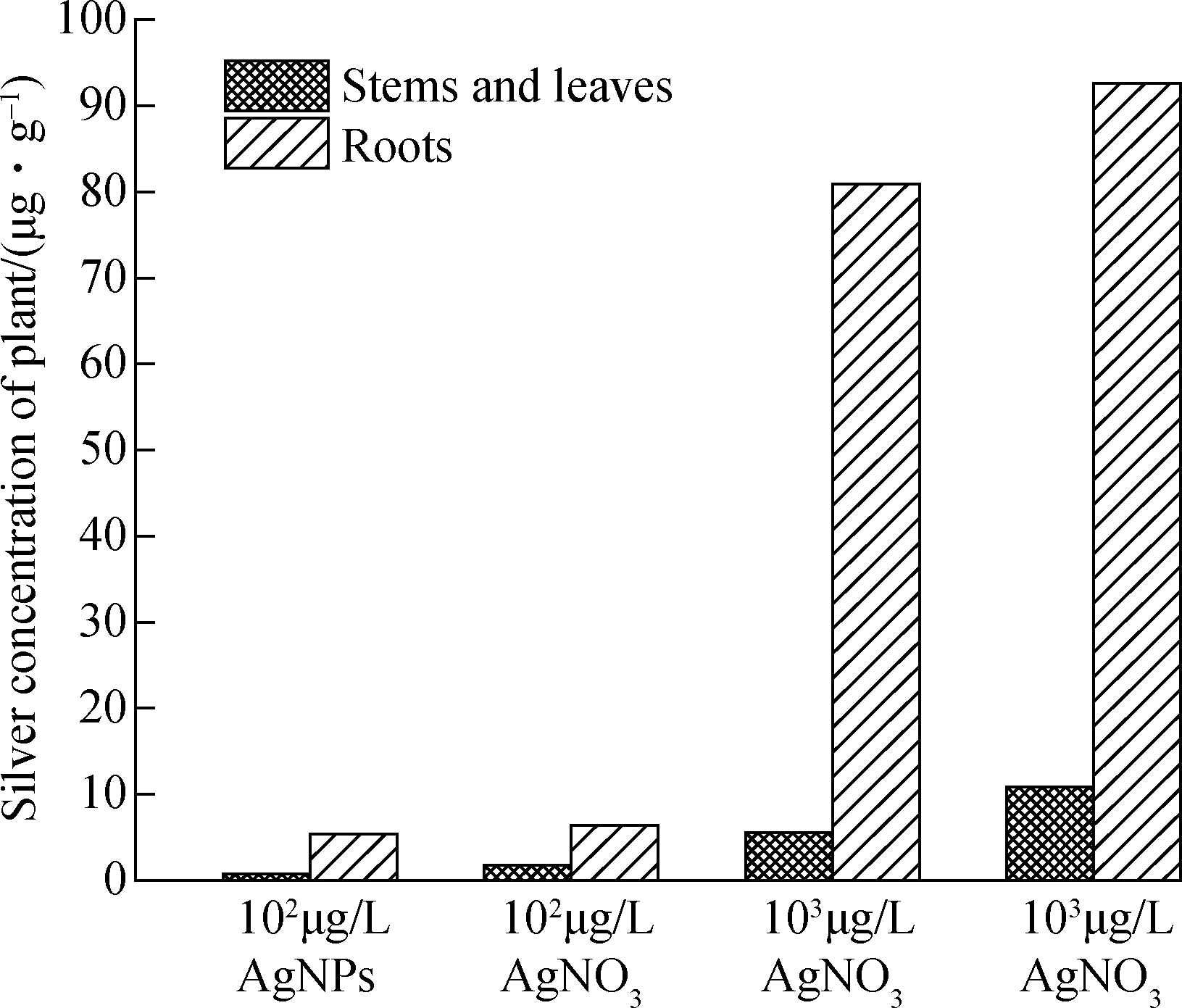
Fig.6 Silver concentrations in the tissues of Eichhornia crassipes after 15 d culture in hydroponic systems with different initial concentrations of AgNPs or AgNO3
As shown in Fig.6, the concentrations of silver absorbed by plants in the AgNP systems were all lower than those absorbed in the AgNO3 systems, which was also consistent with the removal rates of silver in the two systems. Silver ions are more easily absorbed by plants because of the smaller diameters, which are then transferred by transpiration force and nutrient flow in the plan. However, for AgNPs, plants absorb some smaller AgNPs or a small amount of Ag+ dissolved from AgNPs[25].
2.5 Quantitative analyses of AgNPs in a hydroponicsystem
In the Eichhornia crassipes hydroponic systems, a portion of AgNPs remained in the water, and a portion was absorbed by plants. The remaining AgNPs aggregated and settled on the bottom of the container. According to the absorption and translocation pathways of AgNPs and the mass balance principle, the following formulae are used to conduct a quantitative analysis of the absorption and transportation of AgNPs:
Mi=W+P+A
(1)
Rt=P+A
(2)
P=Rp+Lp
(3)
where Mi is the initial content of AgNPs, μg; W is the silver content remaining in water, μg; P is the total silver content absorbed by plant tissues, μg; Rp is the silver absorbed by plant roots, μg; Lp is the silver absorbed by plant stems and leaves, μg; A is the amount of aggregation and settlement, μg; Rt is the total amount of removed silver, μg.
Silver content in the plant roots and leaves were based on the dry weights of plant tissues. In addition to the silver content remaining in the water, the percentages of AgNPs absorbed and transported were calculated (see Tab.1 and Tab.2).
Tab.1 Absorption and transportation of AgNPs in different hydroponic systems μg

MiW RtRpLpPA15.932.7713.160.150.380.5312.6393.3026.5366.774.532.006.5360.241 224.00785.00439.0039.675.9245.59393.4125 950.0020 450.005 500.00259.75121.18380.935 119.07
As shown in Tab.1, with the increase in initial AgNP concentrations, the total amount of silver removed increased accordingly after 15 d. The correlation between the initial concentration and the total amount of silver removed was significant (r=0.99, p<0.001).
As shown in Tab.2,the removal efficiencies of silver decreased with the increase in initial AgNP concentrations, which demonstrated that a saturation ratio was reached to remove AgNPs in these systems. The reason is that the plants limited the absorption capacity to remove the AgNPs and high concentrations of AgNPs might stimulate plant roots to produce exudates that affected the precipitation and aggregation of AgNPs[22]. Within the tested AgNPs concentrations in this study, the percentage of silver removed by plant uptake was the highest at the initial AgNPs concentration of 93.3 μg/L. The decrease of plant uptake might be explained by oxidative stress caused by AgNPs, which might destroy membrane permeability[25] and cell walls[23]. Due to the aggregation at high concentrations of AgNPs, the plant cell wall and membrane might have clogged[24], which can also limit absorption by plants. As also shown in Tab.2, settlement and reunion is a dominant mechanism for the removal of AgNPs in the hydroponic systems. By comparison, the plant absorption of AgNPs is relatively weak.
Tab.2 Distribution of AgNPs at the hydroponic systems %

Total AgNPs loading/μgWater phaseRemoved silverUptake by plantsSedimentation15.9317.482.613.3279.2993.3028.471.567.0064.561 224.0064.135.873.7232.1425 950.0078.821.191.4719.72
3 Conclusions
1) Under the stress of high concentrations of AgNPs, silver concentrations in the water initially deccresed sharply, then decreased slowly, and finally, they showed an increase trend in this study. Under the stress of low concentrations of AgNPs, a large decline in the silver concentration in water occurred initially, which was followed by a gradual decline in later stages.
2) The silver concentrations in water declined continuously in the AgNO3 systems. The silver removal rates in the AgNP systems were lower than those in the AgNO3 systems.
3) The initial AgNP concentrations and the silver accumulation in roots were significantly correlated (r=0.98, p<0.05). A significant correlation (r=1, p<0.001) was also detected between the initial concentrations of AgNPs and the accumulated concentrations of silver in leaves. Most of the silver accumulated in plant roots, whereas only a portion was transferred to stems and leaves.
4) The silver content absorbed by plants in the AgNP systems was lower than that in the AgNO3 systems, which indicates that Ag+ ions are more easily absorbed by plants than the AgNPs.
5) With the increase of the initial AgNPs concentrations, the total amount of removed silver increased, whereas the removal rate decreased at high concentrations. Reunion and settlement were dominant mechanisms for the removal of AgNPs, whereas the absorption by plants had a relatively weak contribution.
[1] Vance M E, Kuiken T, Vejerano E P, et al. Nanotechnology in the real world: Redeveloping the nanomaterial consumer products inventory[J]. Beilstein Journal of Nanotechnology, 2015, 6: 1769-1780. DOI: 10.3762/bjnano.6.181.
[2] Hou L, Li K, Ding Y, et al. Removal of silver nanoparticles in simulated wastewater treatment processes and its impact on COD and NH4 reduction[J]. Chemosphere, 2012, 87(3): 248-252. DOI:10.1016/j.chemosphere.2011.12.042.
[3]García A, Delgado L, Tor J A, et al. Effect of cerium dioxide, titanium dioxide, silver, and gold nanoparticles on the activity of microbial communities intended in wastewater treatment [J]. Journal of Hazardous Materials, 2012, 199-200: 64-72. DOI:10.1016/j.jhazmat.2011.10.057.
J A, et al. Effect of cerium dioxide, titanium dioxide, silver, and gold nanoparticles on the activity of microbial communities intended in wastewater treatment [J]. Journal of Hazardous Materials, 2012, 199-200: 64-72. DOI:10.1016/j.jhazmat.2011.10.057.
[4]Syu Y Y, Hung J H, Chen J C, et al. Impacts of size and shape of silver nanoparticles on Arabidopsis plant growth and gene expression [J]. Plant Physiology and Biochemistry, 2014, 83: 57-64. DOI:10.1016/j.plaphy.2014.07.010.
[5]Navarro E, Baun A, Behra R, et al. Environmental behavior and ecotoxicity of engineered nanoparticles to algae, plants, and fungi [J]. Ecotoxicology, 2008, 17(5): 372-386. DOI:10.1007/s10646-008-0214-0.
[6]Maurer-Jones M A, Gunsolus I L, Murphy C J, et al. Toxicity of engineered nanoparticles in the environment [J]. Anal Chem, 2013, 85(6): 3036-3049. DOI:10.1021/ac303636s.
[7]Wiechers J W, Musee N. Engineered inorganic nanoparticles and cosmetics: Facts, issues, knowledge gaps and challenges [J]. Journal of Biomedical Nanotechnology, 2010, 6(5): 408-431. DOI:10.1166/jbn.2010.1143.
[8]Lin D, Xing B. Root uptake and phytotoxicity of ZnO nanoparticles [J]. Environmental Science & Technology, 2008, 42(15): 5580-5585. DOI:10.1021/es800422x.
[9]Lee J G, Wang Q, Yao Y, et al. Phytotoxicity, accumulation and transport of silver nanoparticles by Arabidopsis Thaliana [J]. Nanotoxicology, 2013, 7(3): 323-337. DOI:10.3109/17435390.2012.658094.
[10]Lee J G, Brooks M, Gerfen J R, et al. Reproductive toxicity and life history study of silver nanoparticle effect, uptake ad transport in Arabidopsis thaliana [J]. Nanomaterials, 2014, 4(4): 301-318. DOI:10.3390/nano4020301.
[11]Harris A T, Bali R. On the formation and extent of uptake of silver nanoparticles by live plants [J]. Journal of Nanoparticle Research, 2008, 10(4): 691-695. DOI:10.1007/s11051-007-9288-5.
[12]Marciano A, Chefetz B, Gedanken A. Differential adsorption of silver nanoparticles to the inner and outer surfaces of the Agave americana cuticle [J]. The Journal of Physical Chemistry C, 2008, 112(46): 18082-18086. DOI:10.1021/jp806654a.
[13]Quah B, Musante C, White J C, et al. Phytotoxicity, uptake, and accumulation of silver with different particle sizes and chemical forms [J]. Journal of Nanoparticle Research, 2015,17: 277. DOI:10.1007/s11051-015-3079-1.
[14]Vymazzl J. Plants used in constructed wetlands withy horizontal subsurface flow: A review [J]. Hydrobiologia, 2011, 674(1): 133-156. DOI:10.1007/s10750-011-0738-9.
[15]Sopjani M, Foller M, Haendeler J, et al. Silver ion-induced suicidal erythrocyte death[J]. Journal of Applied Toxicology, 2009, 29(6): 531-536. DOI:10.1002/jat.1438.
[16]Levard C, Hotze E M, Lowry G V, et al. Environmental transformations of silver nanoparticles: Impact on stability and toxicity[J]. Environmental Science & Technology, 2012, 46(13): 6900-6914. DOI:10.1021/es2037405.
[17]Levard C, Mitra S, Yang T, et al. Effect of chloride on the dissolution rate of silver nanoparticles and toxicity to E. Coli [J]. Environmental Science & Technology, 2013,47(11): 5738-5745. DOI:10.1021/es400396f.
[18]Westerhoff P, Song G X, Hristovski K, et al. Occurrence and removal of titanium at full scale wastewater treatment plants: Implications for TiO2 nanomaterials [J]. Journal of Environmental Monitoring, 2011, 13(5): 1195-1203.DOI:10.1039/c1em10017c.
[19]Yin, L Y, Cheng, Y W, Espinasse, B, et al. More than the ions: The effects of silver nanoparticles on Lolium multiflorum [J]. Environmental Science & Technology, 2011, 45(6): 2360-2367. DOI:10.1021/es103995x.
[20]Unrine J M, Colman B P, Bone A J, et al. Biotic and abiotic interactions in aquatic microcosms determine fate and toxicity of Ag nanoparticles. Part 1. Aggregation and dissolution [J]. Environmental Science & Technology, 2012, 46(13): 6915-6924. DOI:10.1021/es204682q.
[21]Nason J A, McDowell S A, Callahan T W. Effects of natural organic matter type and concentration on the aggregation of citrate-stabilized gold nanoparticles[J]. Journal of Environmental Monitoring, 2012, 14(7): 1885-1892. DOI:10.1039/c2em00005a.
[22]Lee W M, Kwak J I, An Y J. Effect of silver nanoparticles in crop plants Phaseolusradiatus and Sorghum bicolor: Media effect on phytotoxicity [J]. Chemosphere, 2012, 86(5): 491-499. DOI:10.1016/j.chemosphere.2011.10.013.
[23]Kumari M, Mukherjee A, Chandrasekaran N. Genotoxicity of silver nanoparticles in Allium cepa [J]. Science of the Total Environment, 2009, 407(19): 5243-5246. DOI:10.1016/j.scitotenv.2009.06.024.
[24]Asli S, Neumann P M. Colloidal suspensions of clay or titanium dioxide nanoparticles can inhibit leaf growth and transpiration via physical effects on root water transport [J]. Plant, Cell & Environment, 2009, 32(5): 577-584. DOI:10.1111/j.1365-3040.2009.01952.x.
[25]Tan X, Lin C, Fugetsu B. Studies on toxicity of multi-walled carbon nanotubes on suspension rice cells[J]. Carbon, 2009, 47(15): 3479-3487. DOI:10.1016/j.carbon.2009.08.018.